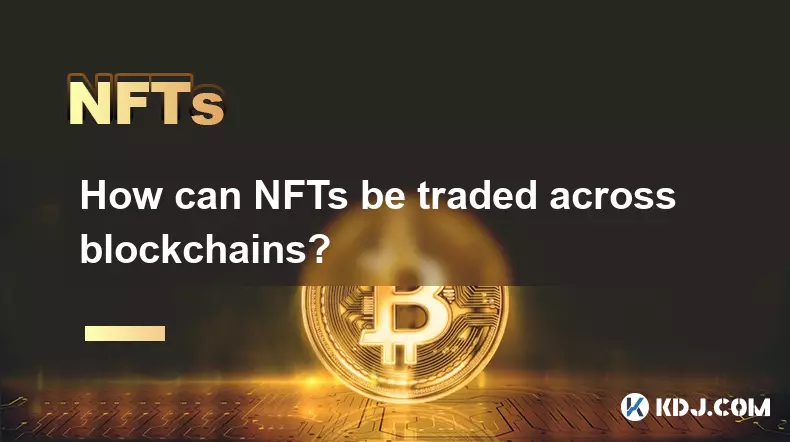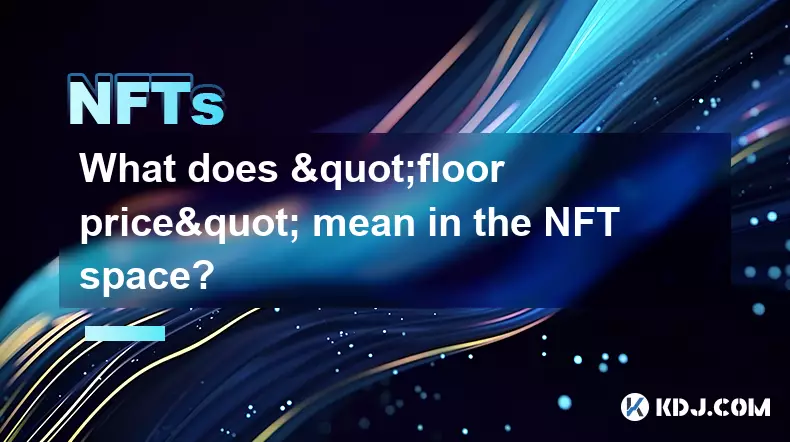-
 bitcoin
bitcoin $109523.663807 USD
-0.13% -
 ethereum
ethereum $4019.526508 USD
2.06% -
 tether
tether $1.000482 USD
0.00% -
 xrp
xrp $2.776815 USD
0.18% -
 bnb
bnb $958.942396 USD
0.12% -
 solana
solana $204.294698 USD
3.84% -
 usd-coin
usd-coin $0.999693 USD
0.00% -
 dogecoin
dogecoin $0.232115 USD
2.09% -
 tron
tron $0.338028 USD
0.84% -
 cardano
cardano $0.790920 USD
1.50% -
 hyperliquid
hyperliquid $44.871443 USD
5.60% -
 ethena-usde
ethena-usde $1.000322 USD
0.04% -
 chainlink
chainlink $21.034165 USD
2.60% -
 avalanche
avalanche $28.794831 USD
-0.54% -
 stellar
stellar $0.360466 USD
1.24%
How can I avoid the risk of a NFT project's floor price crashing?
Understanding floor price dynamics is key to avoiding NFT crashes—monitor market sentiment, whale activity, and trading volume to make informed decisions. (154 characters)
Aug 10, 2025 at 10:21 pm

Understanding Floor Price Dynamics in NFT Projects
The floor price of an NFT collection refers to the lowest price at which a single item from that collection is listed for sale on a marketplace like OpenSea or LooksRare. This metric is crucial because it reflects the market’s current valuation of the least valuable asset in the project. A sudden drop in the floor price can signal weakening demand, loss of community confidence, or manipulative activities. To avoid the risk of a floor price crash, it’s essential to understand the factors that influence it. Market sentiment, trading volume, project roadmap execution, and whale activity all play pivotal roles. Monitoring these indicators in real time allows investors to make informed decisions before a downturn becomes irreversible.
Conducting Thorough Due Diligence Before Investing
Before acquiring any NFT, perform comprehensive research on the project. Start by analyzing the team behind the NFT collection. Are the developers and artists publicly known? Do they have a track record of successful projects? Verify their social media presence and engagement levels. Next, examine the smart contract—use tools like Etherscan to confirm if the contract has been audited and whether it includes red flags such as minting functions that allow unlimited supply. Additionally, review the roadmap and utility promises. Projects offering real-world benefits, such as access to events, staking rewards, or exclusive merchandise, tend to maintain stronger floor prices. A well-documented whitepaper or project manifesto adds credibility.
Assessing Community Health and Engagement
The strength of an NFT project’s community is a major predictor of its long-term stability. A vibrant, active community can act as a buffer against floor price crashes by sustaining demand even during market downturns. To evaluate community health, join the project’s Discord and Telegram groups. Look for consistent communication from the team, regular updates, and organic discussions among members. Avoid projects where most messages are bot-generated or where moderators suppress criticism. High engagement rates on Twitter (X) and Instagram—such as likes, retweets, and meaningful comments—are also positive signs. A community that believes in the project’s vision is more likely to hold during volatility, preventing panic selling.
Monitoring On-Chain and Marketplace Data
Real-time data analysis is a powerful tool for risk mitigation. Use platforms like NFTFloor, Dune Analytics, or CryptoSlam to track key metrics. Pay close attention to the following:
- Number of unique holders: A growing base suggests organic interest.
- Whale concentration: If a small number of wallets hold a large percentage of the collection, the floor price is vulnerable to sudden dumps.
- Sales volume trends: Declining volume over several days may indicate waning interest.
- Listings vs. sales ratio: A high number of listings with few sales suggests oversupply and potential downward pressure.Set up alerts for unusual activity, such as a top holder selling multiple NFTs at once. These insights allow you to exit or adjust your position before a crash materializes.
Implementing Strategic Buying and Selling Tactics
Timing and strategy are critical in minimizing exposure to floor price crashes. Instead of buying during peak hype, consider entering during dips in floor price when panic selling occurs but fundamentals remain strong. Use limit orders on marketplaces to avoid overpaying. When selling, avoid dumping large quantities at once, as this can trigger a chain reaction of price drops. Instead, sell gradually or use Dutch auctions to find the optimal price. Diversify your NFT portfolio across multiple projects to reduce reliance on any single collection. Never allocate more funds than you can afford to lose, and treat NFTs as high-risk assets.Leveraging Tools for Real-Time Risk Management
Several tools can help you stay ahead of potential floor price collapses. Blur.io offers advanced analytics and sniping tools that allow you to monitor listing changes and sales in real time. Rarity tools help identify undervalued NFTs within a collection, enabling smarter buying decisions. Use wallet tracking services like Nansen or Whale Alert to monitor movements from known whale wallets. If a major holder begins transferring NFTs to an exchange, it could signal an upcoming sale. Integrating these tools into your routine provides an early warning system, giving you time to react.Frequently Asked Questions
Can a high trading volume prevent a floor price crash? High trading volume can temporarily support a floor price by creating the appearance of demand. However, if the volume is driven by wash trading—where the same party buys and sells to inflate activity—it does not reflect genuine market interest. Always verify volume authenticity using blockchain explorers and analytics platforms.What role do NFT marketplaces play in floor price stability?Marketplaces influence visibility and liquidity. Collections listed on top platforms like OpenSea benefit from greater exposure, which can stabilize prices. However, if a marketplace delists a project due to fraud or inactivity, the floor price can plummet overnight. Ensure the project maintains good standing on major platforms.
How do airdrops and giveaways affect floor price?Well-executed airdrops to loyal holders can boost morale and reduce selling pressure. However, mass airdrops to random wallets may increase supply without adding value, leading to immediate dumping. Evaluate the intent and targeting of any airdrop before considering it a positive signal.
Is it safe to buy NFTs right after minting?Purchasing immediately after minting carries high risk. Early price surges are often driven by speculators who exit quickly. Wait for the initial volatility to settle, assess the project’s post-mint activity, and confirm that the team is fulfilling promises before entering.
Disclaimer:info@kdj.com
The information provided is not trading advice. kdj.com does not assume any responsibility for any investments made based on the information provided in this article. Cryptocurrencies are highly volatile and it is highly recommended that you invest with caution after thorough research!
If you believe that the content used on this website infringes your copyright, please contact us immediately (info@kdj.com) and we will delete it promptly.
- XRP Tundra: Dual-Token Innovation in the XRP Ecosystem
- 2025-09-27 20:25:12
- MUTM: Is This Crypto the Smartest Buy Now?
- 2025-09-27 20:25:12
- Crypto Millionaires: Unlocking Financial Freedom with the Right Investments
- 2025-09-27 20:30:01
- ETH Price Check: Crypto Analysts Favor These Moves Now
- 2025-09-27 20:30:01
- BlockchainFX, Bitcoin Hyper, and Crypto Presales: Finding the Next Big Thing
- 2025-09-27 20:30:01
- Galaxy CEO, Bitcoin, and the Powell Replacement: A $200K Prediction?
- 2025-09-27 20:30:15
Related knowledge

How can I determine the authenticity of an NFT project?
Sep 23,2025 at 05:18pm
Understanding the Project Team and Their Background1. Research the identities of the team members behind the NFT project. Verified social media profil...

What's the difference between NFTs and traditional collectibles?
Sep 19,2025 at 12:55pm
Digital Ownership and Provenance1. NFTs are built on blockchain technology, which ensures transparent and immutable records of ownership. Every transa...

How can NFTs be traded across blockchains?
Sep 19,2025 at 12:00pm
Understanding Cross-Chain NFT Trading1. Non-fungible tokens (NFTs) are digital assets that represent ownership of unique items on a blockchain. Origin...

How is NFT rarity calculated?
Sep 18,2025 at 07:54pm
Understanding NFT Rarity Metrics1. NFT rarity is determined by analyzing the uniqueness of individual traits within a collection. Each NFT typically c...

What does "floor price" mean in the NFT space?
Sep 22,2025 at 06:36am
Floor Price: A Core Metric in the NFT Marketplace1. The term floor price refers to the lowest current asking price for any item within a specific NFT ...

How do NFTs help content creators?
Sep 18,2025 at 08:00am
NFTs Empower Creators with Ownership and Monetization1. NFTs provide content creators with verifiable ownership of their digital works, ensuring authe...

How can I determine the authenticity of an NFT project?
Sep 23,2025 at 05:18pm
Understanding the Project Team and Their Background1. Research the identities of the team members behind the NFT project. Verified social media profil...

What's the difference between NFTs and traditional collectibles?
Sep 19,2025 at 12:55pm
Digital Ownership and Provenance1. NFTs are built on blockchain technology, which ensures transparent and immutable records of ownership. Every transa...

How can NFTs be traded across blockchains?
Sep 19,2025 at 12:00pm
Understanding Cross-Chain NFT Trading1. Non-fungible tokens (NFTs) are digital assets that represent ownership of unique items on a blockchain. Origin...

How is NFT rarity calculated?
Sep 18,2025 at 07:54pm
Understanding NFT Rarity Metrics1. NFT rarity is determined by analyzing the uniqueness of individual traits within a collection. Each NFT typically c...

What does "floor price" mean in the NFT space?
Sep 22,2025 at 06:36am
Floor Price: A Core Metric in the NFT Marketplace1. The term floor price refers to the lowest current asking price for any item within a specific NFT ...

How do NFTs help content creators?
Sep 18,2025 at 08:00am
NFTs Empower Creators with Ownership and Monetization1. NFTs provide content creators with verifiable ownership of their digital works, ensuring authe...
See all articles









































































